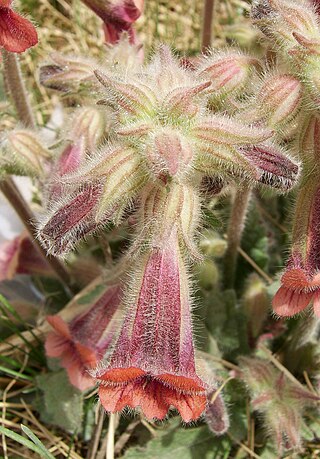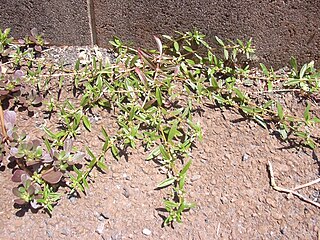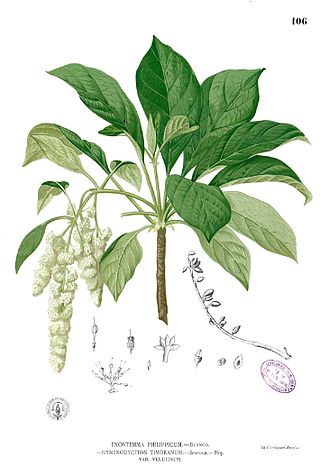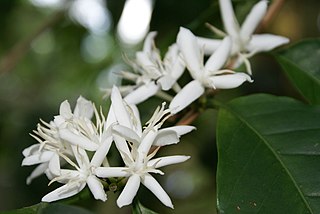Related Research Articles

Gentianales is an order of flowering plant, included within the asterid clade of eudicots. It comprises more than 20,000 species in about 1,200 genera in 5 families. More than 80% of the species in this order belong to the family Rubiaceae.

The Scrophulariaceae are a family of flowering plants, commonly known as the figwort family. The plants are annual and perennial herbs, as well as shrubs. Flowers have bilateral (zygomorphic) or rarely radial (actinomorphic) symmetry. The Scrophulariaceae have a cosmopolitan distribution, with the majority found in temperate areas, including tropical mountains. The family name is based on the name of the included genus Scrophularia L.

The Primulaceae, commonly known as the primrose family, are a family of herbaceous and woody flowering plants including some favourite garden plants and wildflowers. Most are perennial though some species, such as scarlet pimpernel, are annuals.

Plantaginaceae, the plantain family, is a large, diverse family of flowering plants in the order Lamiales that includes common flowers such as snapdragon and foxglove. It is unrelated to the banana-like fruit also called "plantain." In older classifications, Plantaginaceae was the only family of the order Plantaginales, but numerous phylogenetic studies, summarized by the Angiosperm Phylogeny Group, have demonstrated that this taxon should be included within Lamiales.

The Loganiaceae are a family of flowering plants classified in order Gentianales. The family includes up to 13 genera, distributed around the world's tropics. There are not any great morphological characteristics to distinguish these taxa from others in the order Gentianales.

Phrymaceae, also known as the lopseed family, is a small family of flowering plants in the order Lamiales. It has a nearly cosmopolitan distribution, but is concentrated in two centers of diversity, one in Australia, the other in western North America. Members of this family occur in diverse habitats, including deserts, river banks and mountains.

Rehmannia is a genus of seven species of flowering plants in the order Lamiales and family Orobanchaceae, endemic to China. It has been placed as the only member of the monotypic tribe Rehmannieae, but molecular phylogenetic studies suggest that it forms a clade with Triaenophora. Contrary to the immense majority of the taxa of Orobanchaceae, Rehmannia is not parasitic.

In the APG IV system (2016) for the classification of flowering plants, the name asterids denotes a clade. Asterids is the largest group of flowering plants, with more than 80,000 species, about a third of the total flowering plant species. Well-known plants in this clade include the common daisy, forget-me-nots, nightshades, the common sunflower, petunias, yacon, morning glory, lettuce, sweet potato, coffee, lavender, lilac, olive, jasmine, honeysuckle, ash tree, teak, snapdragon, sesame, psyllium, garden sage, table herbs such as mint, basil, and rosemary, and rainforest trees such as Brazil nut.

Oldenlandia is a genus of flowering plants in the family Rubiaceae. It is pantropical in distribution and has about 240 species. The type species for the genus is Oldenlandia corymbosa.

Kadua is a genus of flowering plants in the family Rubiaceae. It comprises 29 species, all restricted to Polynesia. Twenty-two of these are endemic to the Hawaiian Islands. Some of the species are common at high elevation. Others are single-island endemics or very rare, and a few are probably extinct. Kadua affinis is widely distributed in Hawaii and is polymorphic. The type species for the genus is Kadua acuminata.

Naucleeae is a tribe of flowering plants in the family Rubiaceae and contains about 183 species in 24 genera. Species belonging to Naucleeae occur from Australasia, tropical Asia, Madagascar, tropical Africa, and to the Neotropics and North America.

The Cinchoneae are a tribe of flowering plants in the family Rubiaceae containing about 125 species in 9 genera. Representatives are found from Costa Rica to southern tropical America. Species within Cinchoneae are characterized as small trees or shrubs with imbricate or valvate corolla aestivation and often dry capsular fruits. Many species contain alkaloids.

Hymenodictyeae is a tribe of flowering plants in the family Rubiaceae and contains about 25 species in two genera. The representatives of the genus Hymenodictyon are found in tropical and southern Africa, Madagascar, to tropical Asia and China (Yunnan). The two species of Paracorynanthe are restricted to Madagascar.
Danaideae is a tribe of flowering plants in the family Rubiaceae and contains 67 species in 3 genera. Its representatives are found in Tanzania and several islands in the western Indian Ocean: Comoros, Mauritius, Madagascar, and Réunion.

Kåre Bremer is a Swedish botanist and academic. He has also been Vice-Chancellor of Stockholm University.

Coffeeae is a tribe of flowering plants in the family Rubiaceae and contains about 333 species in 11 genera. Its representatives are found in tropical and southern Africa, Madagascar, the western Indian Ocean, tropical and subtropical Asia, and Queensland.

Octotropideae is a tribe of flowering plants in the family Rubiaceae and contains about 103 species in 18 genera. Its representatives are found in the paleotropics. The genera previously placed in the tribe Hypobathreae are now placed in Octotropideae.

Psychotrieae is a tribe of flowering plants in the family Rubiaceae and contains about 2114 species in 17 genera. Its representatives are found in the tropics and subtropics. Several genera are Myrmecophytes
Augusteae is a tribe of flowering plants in the family Rubiaceae and contains 89 species in 3 genera. Augusta is found from Mexico to Brazil and in the southwestern Pacific region, Wendlandia is found in northeastern tropical Africa, tropical and subtropical Asia and Queensland, and Guihaiothamnus is found in South China.
Palicoureeae is a tribe of flowering plants in the family Rubiaceae and contains about 817 species in 11 genera. Its representatives are found in the tropics and subtropics.
References
- ↑ "Harvard University Herbaria & Libraries".
- ↑ Taxonomy of Schistidium
- ↑ "Birgitta Bremer – Bergius Botanic Garden". Archived from the original on 2019-02-07. Retrieved 2018-08-02.
- ↑ "Kungl. Vetenskapsakademien". Archived from the original on 2022-03-10. Retrieved 2018-08-02.
- ↑ International Plant Names Index. B.Bremer.